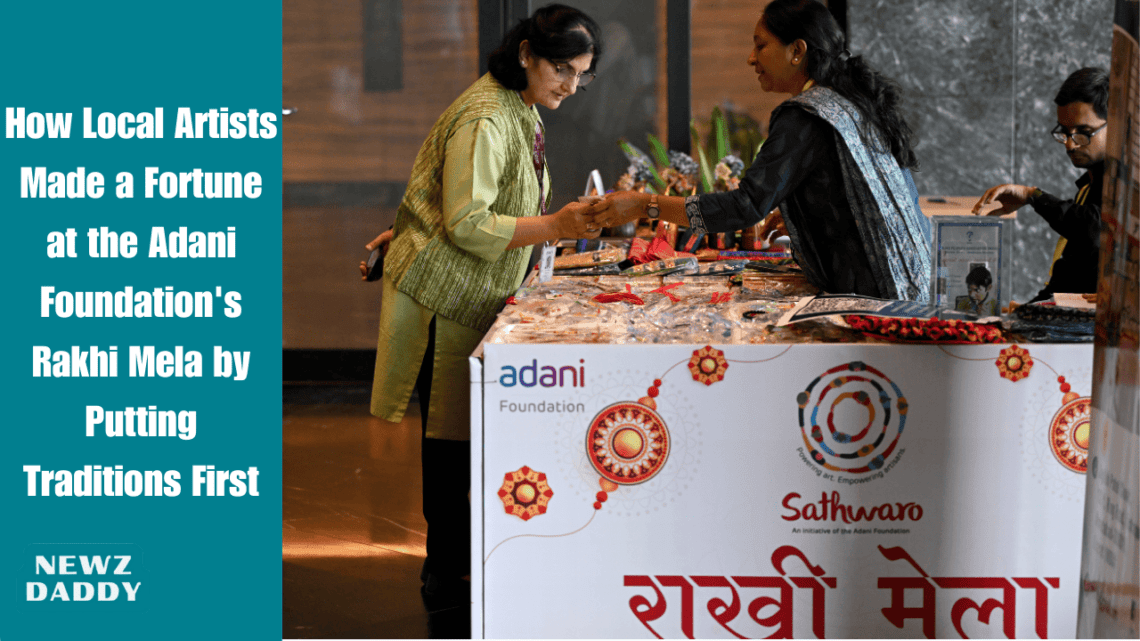How Local Artists Made a Fortune at the Adani Foundation’s Rakhi Mela by Putting Traditions First
Synopsis
- Event: Adani Foundation organized a Rakhi Mela at Adani Group Headquarters as part of Project Sathwaro.
- Participants: Rakhis were handcrafted by 10 artisans from Gujarat.
- Involvement: Students from the Blind People’s Association/Andhjan Mandal and Adani Vidya Mandir, Ahmedabad, showcased and sold their creations.
- Success: Artisans sold Rakhis worth over Rs. 1 lakh.
- Types of Rakhis: Varieties included Crochet, Embroidery, Beadwork, threadwork, Agate stone, Silver Filigree, and Resin art Rakhis.
- Purpose: To promote traditional Indian crafts and support local artisans.
- Mentor: Mrs. Shilin Adani, Trustee of the Adani Foundation, mentored Project Sathwaro and congratulated the artisans.
- Goal: The Adani Foundation’s mission aligns with the United Nations’ Sustainable Development Goals to boost economic opportunities and preserve cultural heritage through community support.
Adani Foundation Promotes India’s Artistic Heritage at Rakhi Mela
Just in time for the joyous Raksha Bandhan holiday, the Adani Foundation threw a colorful Rakhi Mela at the Adani Group Headquarters in Ahmedabad. The goal of this two-day Project Sathwaro event was to empower local craftspeople to energize art. The campaign skilfully combined ancient Indian crafts with contemporary marketing, as the artists displayed their meticulously created rakhis that were thoughtfully and creatively designed.
Emphasis on Traditionally Made Rakhis by Artists
Ten gifted craftspeople from all around Gujarat were chosen to take part in this event. Rakhi is a decorative thread that represents the sibling bond. Each artist added a special touch to the craft. These craftspeople combined modern styles with the rich creative traditions of Gujarat as inspiration. In addition, children from Adani Vidya Mandir in Ahmedabad and the Blind People’s Association in Vastrapur, better known as Andhjan Mandal, gave their exquisite handcrafted rakhis to the ceremony.
The Rakhis that were on show were works of art rather than just strings of yarn. There was something for everyone, ranging from sophisticated Silver Filigree designs to complex Crochet Rakhis. Additionally well-represented were beadwork, embroidery, and threadwork, demonstrating the skill and variety of these craftspeople. Rakhis made of resin art and agate stone was available for those seeking something special, giving the customary festival a contemporary spin.
Must Read:
The Ground-Breaking Fundraisal by AESL: A New Chapter in Power Solutions
A Forum for Regional Craftspeople and Communities
The Rakhi Mela offered the craftsmen a chance to make money, which was one of its delights. The craftsmen were successful in selling rakhis for over Rs. 1 lakh during the two days. In addition to the financial benefits, this gave these craftsmen much-needed exposure to a larger audience, enabling them to carry on honing and maintaining their skills.
The occasion provided a forum for promoting awareness of the value of maintaining traditional arts in the face of contemporary difficulties. Initiatives such as these are essential in promoting and conserving the distinctive crafts that are an essential element of India’s cultural history in a time when mass-produced commodities sometimes take precedence over handmade items.
The Function of Project Sathwaro in Developing Artists
The Rakhi Mela was arranged under Project Sathwaro, one of the Adani Foundation’s signature programs that aims to empower craftsmen and promote art. The project aims to improve the economic and social standing of artisans by putting a strong emphasis on skill development and giving them outlets to market their products. It also fits into the Adani Foundation’s larger goal of supporting the Sustainable Development Goals (SDGs) of the UN, which center on preserving cultural heritage, fostering economic growth, and providing possibilities for livelihood. The project extends beyond isolated occasions. Through ongoing endeavors including assistance for self-help organizations and training courses, Project Sathwaro cultivates a mindset of independence among craftspeople. In addition to guaranteeing the continuation of India’s rich artistic legacy, it supports sustainable livelihoods.
Adani Foundation Involvement and Leadership
This event would not have been possible without the Adani Foundation’s direction and assistance. The foundation’s trustee, Mrs. Shilin Adani, is essential in providing mentorship to the craftspeople engaged in Project Sathwaro. She thanked each artist for their amazing achievement at the Rakhi Mela. Her participation is indicative of the Adani Foundation’s larger dedication to community development and social welfare.
In line with the Sustainable Development Goals of the United Nations
The Adani Foundation works to promote economic growth, create jobs, and preserve culture—all of which are in line with the UN Sustainable Development Goals. The foundation helps to preserve traditional crafts and promotes an inclusive economy by arranging events like the Rakhi Mela, which gives craftsmen better access to markets and growth prospects.
The Adani Foundation’s Work’s Wider Impact
The Adani Foundation’s activity goes well beyond crafts and the arts. It deals with many community development issues, such as sustainability of the environment, health, and education. The foundation is essential in raising the standard of living for many disadvantaged groups in society because of its emphasis on empowering people and fostering economic progress.
The charity helps craftsmen and other community people become self-sufficient through projects like Project Sathwaro and skill-development programs. This in turn promotes a circle of empowerment and growth and advances society as a whole.
The Rakhi Mela organized by the Adani Foundation not only celebrated the festive spirit of Raksha Bandhan but also highlighted the importance of sustaining traditional crafts. It provided a platform for local artisans and students to showcase their talents while promoting the broader mission of the foundation to align with the UN’s Sustainable Development Goals. With support from leaders like Mrs. Shilin Adani and initiatives like Project Sathwaro, the future of India’s artistic heritage and artisan communities looks bright and full of promise.
Must Read:
Gujarat Celebrates the Adani Foundation’s Historic Reforestation Achievement




